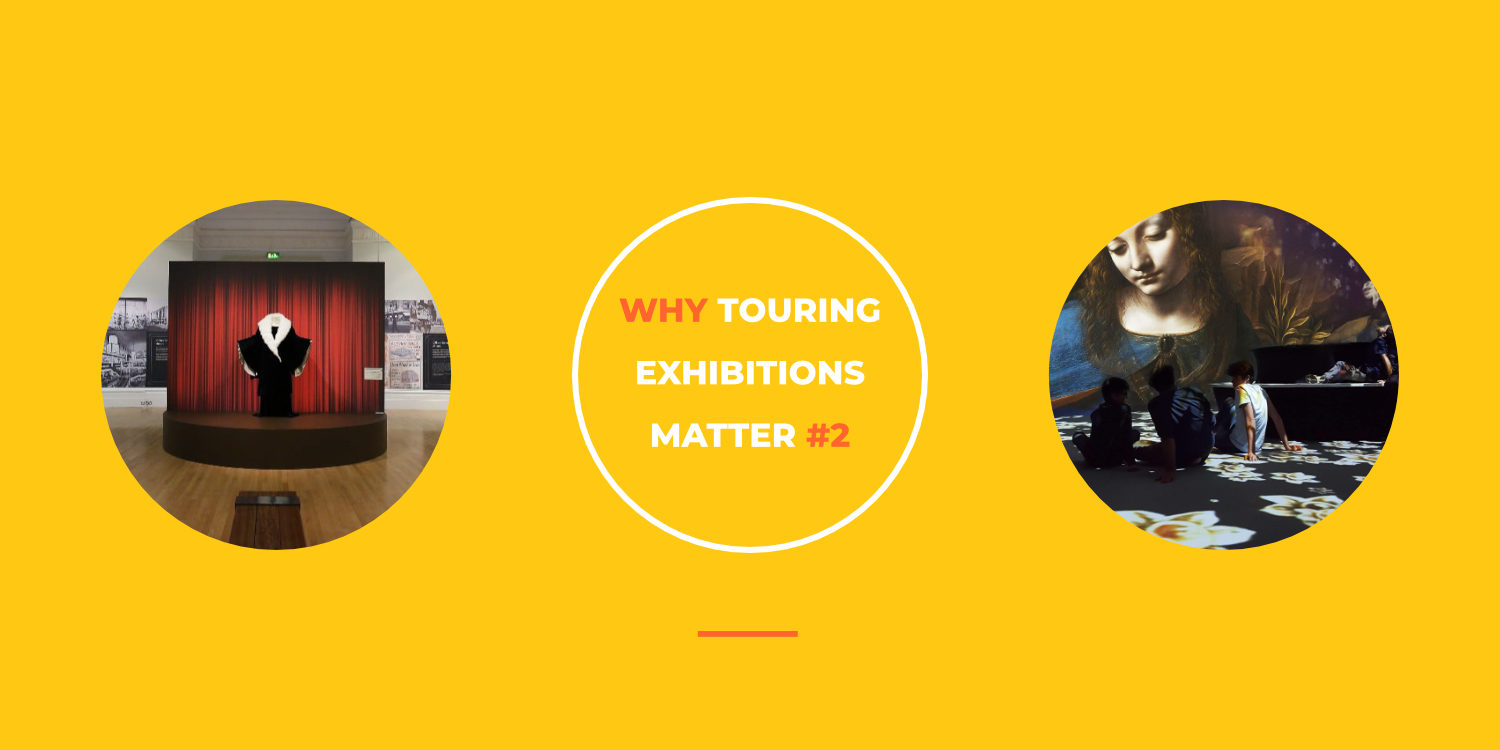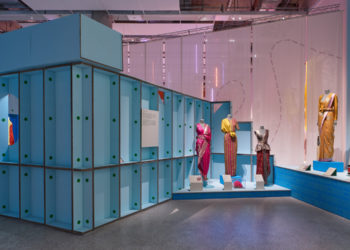#2 – Rethinking connections with remote audiences is the second article in the Why Touring Exhibitions Matter series by Teo. This series of articles aims to highlight the value of travelling exhibitions in the context of the multi-layered crisis cultural institutions and their audiences are currently facing. The series questions how these creative productions and the collaborations they foster are essential sources of value for cultural institutions and their audiences at large, and how they will be, and already are, key resources for recovery in the cultural world and beyond. In this second article, we explore how travelling exhibitions, virtual and physical, can be original resources for cultural institutions to rejuvenate the relationship with existing and potential remote audiences.
Brand awareness and engagement at risk
One could consider that now is the time for cultural institutions to focus almost exclusively on local audiences1, since more remote audiences – those who are geographically distant, as well as local audiences who face accessibility barriers or lockdown scenario challenges – cannot physically come to the museum or visit cultural institutions. But in the same way that now is crucial for local audiences’ engagement, it is actually also a unique moment in time to reinvent the connection with remote audiences. This is particularly true for major institutions who have a long-established connection with national and international audiences. As tourists and travellers, as well as some local audiences, are prevented from coming, it is certainly not the time to forget about them.
Previous visitors, as well as potential future newcomers from these remote audiences, should be carefully considered. Not only do they represent a pool of future visitors, but also of existing and future ambassadors. These existing and potential advocates play a crucial connector role in spreading the good word about the institution and building incentives to visit for new as well as existing audiences, especially at a time of uncertainty where peer recommendations are becoming increasingly meaningful. It is of utmost importance that this word of mouth and advocacy process continues despite the multiple challenges currently faced by institutions and their various audiences.
Audiences will remember the pandemic and how international institutions cared about them during this time. And the stories they told them. And the dialogue they enabled with them.
Brand awareness and engagement, the ability for an institution to be known, considered, liked, remembered, loved, and supported, can fade surprisingly quickly if the relationship with regular and core audiences is not nourished, and if new audiences are not continuously being sought. For many reasons, cultural venues can gradually drop in priority among favoured destinations for cultural experiences through the long crisis. With so many popular institutions having been shaken up, international audiences have had, and will have, unprecedented occasions to find regional and international alternatives and to engage with other organisations, especially with those who demonstrate true attention to them – who show that they care about them in these difficult times.
In an already fierce landscape of cultural brands, cultural organisations who provide cultural experiences, and in particular museums and galleries, are now being challenged more intensely and differently by other brands, especially those who have found and implemented ways to build familiarity more accurately and have the potential to share the arena with them. Some might now even become able to supersede them and build a stronger brand awareness and emotional connection with these remote audiences, when that was not a possibility before. Just like they will with brands in other realms of their lives, audiences will remember the pandemic and how international institutions cared about them during this time. And the stories they told them. And the dialogue they enabled with them.
Erasing distance with virtual touring exhibitions
In this context, being aware of the dynamic and shifting landscape and maintaining connections with existing and potential remote audiences, regionally, nationally and internationally, will be crucial for cultural institutions. Many are actively engaging with remote audiences through digital channels, with a variety of digital programmes. Programmes often feature virtual explorations of physical exhibitions presented at their venues, recorded in 2D or 3D formats that enable remote visits. Becoming Jane by National Geographic, Leonardo’s World by the Lower Saxony State Museum and Expona, An English Lady’s Wardrobe by National Museums Liverpool, and Maya by MuseumsPartner are great examples of these immersive online experiences offered to all. Institutions thus create opportunities for their existing exhibitions to become a different kind of travelling exhibition by making them accessible online – ‘travelling’ here in the sense that the content and collections can be experienced by new audiences, in other areas of the world, at different times, but in an exclusively digital format delivered through digital channels.
Museums and other cultural institutions can go further by developing virtual institutional exhibitions created especially for online audiences, and communicated as such. These digital exhibitions are designed to be presented on virtual channels, as full experiences in their own right. Remote audiences have the possibility to engage remotely with the institution’s curated content, iconic collections and original stories, through richly designed digital explorations with multi-layered interpretation, created for them as digital audiences by the curatorial and digital teams.
As part of these new engagement ecosystems, augmented online exhibitions can become a new platform to nurture and reinvent the relationship with remote audiences.
These digital “touring” exhibitions are not intended as a simple extension of a physical exhibition, or to replace the physical offer: nothing can replace the experience of being in the actual presence of an original artwork or artefact, or immersed in a multisensorial exhibition experience, with other people in the same room. Instead, they propose an additional and complementary layer of experience, either directly connected to physical experiences presented at the venue, or as standalone exhibitions.
These exhibitions can be integrated in a genuine inclusive multiplatform model connecting physical and digital content, with a diverse and robust transmedia offer which enables onsite visits and a highly accessible experience extended to remote audiences. ACMI, Australia’s national museum of screen culture, has thus just launched an “entirely new online presence, inviting people to visit [the] museum no matter where they are in the world.” Conceptualised by ACMI Director & CEO Katrina Sedgwick OAM in 2015, this integrated cross-media storytelling approach is based on the principle that “in the same way we curate and design exhibitions and programs for the physical museum, we have been developing them specifically for online across the breadth of screen culture – film, TV, videogames and art.” As ACMI’s Chief Experience Officer Seb Chan explains in the institution’s relaunch interviews, ACMI has created “a highly connected ecosystem of curated content” which powerfully extends the visitor exploration. As part of this initiative, ACMI is notably opening Gallery 5, a new digital exhibition space where the team will present a dedicated stream of online-only artworks and performances.
As part of these new engagement ecosystems, augmented online exhibitions can become a new platform to nurture and reinvent the relationship with remote audiences. In particular, they can offer new opportunities for dialogue and interactions with the institution’s teams and amongst visitors, for the development of user-generated content and for participatory exhibit development.
These digital touring exhibitions can be proposed in a variety of formats by institutions to foster new revenue and relationships. They could be fully accessible online or proposed as events with gated access, with a paid “entrance fee” or with membership access. They could be proposed directly on the producing institution’s website, or on a host’s digital channels for a limited time, as a hired digital travelling exhibit. Universcience, for instance, is currently proposing some of the institution’s digital exhibitions on the French Alliance’s website in Brazil. Live events, such as tours by curators or artists’ online performances, where remote audiences can join in, and in some instances even participate, could be interesting additional components to these virtual experiences, which would contribute to differentiating these cultural offers from simple online offers. As resources that are only just beginning to be further explored, they can become particularly engaging moments for remote audiences. And showcase online exhibitions, which would share the essence and highlights of the home institution, could be particularly effective proposals to explore to connect with remote audiences.
“We have seen a dramatic increase in virtual exhibitions over the last 12 months. Interestingly, the last half of 2020 has seen a significant trend in time-limited online exhibitions. In our view this represents a maturity in the technology and a significant shift in how GLAM organisations will utilise online technologies into the future.”
Dr Lazaros Kastanis, Director of Ortelia Pty Ltd
Erasing distance with showcase international exhibitions
Physical international exhibitions proposed on tour by cultural institutions can also be a compelling way to fuel the relationship with remote audiences and create opportunities to initiate new relationships. Acting as ambassador projects for their home institutions, these travelling exhibitions can also offer remote audiences new opportunities to engage with the institution’s content, collections and stories.
This is particularly true for major flagship exhibitions which present highlights from the institution’s collections or explore popular themes that echo their expertise and are naturally associated with their brands. An augmented version of such exhibitions could be productions created especially in response to the exceptional situation and communicated as genuine landmark showcases of their home institutions, intended to bring the institution’s experience to its wider target audiences who are unable to come to the venue. For example, creating “a mini National Museum” or an “Orsay Museum to you” exhibition, featuring iconic objects and art works from their collections, conveying the institution’s essence. These productions could tour around the world as crisis ambassadors for their home institutions.
These could be supported with communication campaigns with strong storytelling, highlighting how the institution cares about all their audiences. The core message could be: “Cannot come to us? We will come to you, because we care about you”. Or “You are far from us, but we still hear you, listen to you and engage with you”. Such travelling exhibitions could be communicated as once-in-a-lifetime opportunities to discover exceptional treasures and curated stories from the lender institution, and as providing a rare moment for a unique encounter. They would be particularly powerful vehicles for engaging with national and international audiences and nurturing these critical relationships through unprecedented times.
Beyond the institutional brand awareness and engagement these exhibitions can serve, there is also the potential for such travelling productions to act as ambassadors for a site, a city or a country. In the same way that the crisis puts brand resonance at risk for institutions who have a long-established tradition of engaging with remote audiences, the brand impact of major cities and countries as destinations for tourists and travellers is also majorly challenged by the current multi-layered crisis, with travelling cards being unprecedently reshuffled. Travelling exhibitions that convey the essence of a specific place can also be solid resources for maintaining relationships with remote audiences and continuing to connect to new audiences despite their current inability to travel. The new Lascaux Exhibition , which offers a large-scale virtual reality exploration of the world famous archaeological site, thus proposes a very unique opportunity for visitors to visit a site that cannot be accessed – the Lascaux visitor sites cannot currently be experienced, and the original site has actually been closed to the public since 1963. This exhibition provides visitors with a special encounter with France heritage, despite travel restrictions.
“Despite museum closures and limitations on travel, works of art and curatorial ideas still have no borders. It's become even more important now, in the very unique times we experience, that art and creations do travel and remain accessible to the largest numbers and everywhere, since culture has the power to unite and heal. At times when people, our audiences, are prevented from travelling freely, it becomes even more important today to have our collections, experiences, exhibitions travel to them and cultivate an even tighter bond.”
Sampiero Lanfranchi, CEO, Chargeurs Creative Collection
Button TextThe current context is leading to a rapidly changing landscape of audiences and competing offers for cultural institutions. It represents a unique moment to rethink the relationship with existing and new, local and remote audiences, and to overcome the opposition between remote versus local, as well as to consider them equally, and together, crafting multiple dialogues – thinking outside the box to foster recovery in the cultural world and beyond.
Sources
1 Teo. (2020, October 15). A new dialogue framework with local audiences. Retrieved 6 November 2020, from https://www.teo-exhibitions.com/a-new-dialogue-framework-with-local-audiences/
Interview with Dr Lazaros Kastanis, Director of Ortelia Pty Ltd, a company specialising in the delivery of interactive cultural experiences
Interview with Sampiero Lanfranchi, COO, Chargeurs Creative Collection, specialists in experiential environments and museum developments
ACMI. (2020, October 13). ACMI – ACMI set to open the world’s most digitally transformed museum. Retrieved 5 November 2020, from https://www.acmi.net.au/about/media/media-releases/acmi-set-open-worlds-most-digitally-transformed-museum/
Exhibitions featured in the cover image
Leonardo’s World, by Expona
An English Lady’s Wardrobe, by National Museums Liverpool
Exhibitions mentioned
An English Lady’s Wardrobe, by National Museums Liverpool
Visit the Entire Lascaux, by SPL Lascaux
Becoming Jane, by National Geographic
Leonardo’s World, by Expona
Maya, by MuseumsPartner
Exhibitions by ACMI
Exhibitions by Universcience



